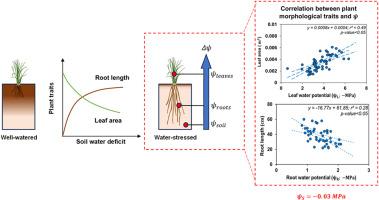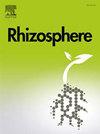Correlation between plant morphological traits and water potential exhibits drought avoidance in Chrysopogon zizanioides
IF 3.4
3区 生物学
Q1 PLANT SCIENCES
引用次数: 0
Abstract
Plant acclimation to drought involves morphological changes such as leaf shrinkage and root elongation. We sought correlations between drought acclimated plant morphological traits and water potential of leaf () and root (), which are limitedly available. Leaves and roots of Chrysopogon zizanioides L. (vetiver) grown for different periods (3, 4 and 5 months) in biochar amended sandy soil were sampled at a soil water potential () representing drought condition. Morphological traits including leaf area, root diameter and root length were determined to correlate with and . Leaf area and root length increased with increasing growth period, but root diameter remained largely constant. Leaf area and was positively and linearly correlated. Root diameter and root length displayed a contrasting response with ; lower was measured in larger root diameters and shorter root lengths. Vetiver grass avoided the drought stress by increasing their root length, which will benefit the use of this species for soil bioengineering. The proliferation of roots to deeper soil depths could stabilise soil sliding and at the same time survive under drought conditions.

Chrysopogon zizanioides 植物形态特征与水势显示的抗旱性之间的相关性
植物对干旱的适应包括形态变化,如叶片萎缩和根系伸长。我们寻求干旱适应植物形态特征与叶片(ψL)和根部(ψR)水势之间的相关性。在代表干旱条件的土壤水势(ψS)下,对在生物炭改良过的沙质土壤中生长了不同时期(3、4 和 5 个月)的香根草(Chrysopogon zizanioides L.)的叶片和根部进行了取样。测定了叶面积、根直径和根长等形态特征与ψL 和ψR 的相关性。叶面积和根长随着生长期的延长而增加,但根直径基本保持不变。叶面积和ψL呈线性正相关。根直径和根长度与ψR的反应相反;ψR越低,根直径越大,根长度越短。香根草通过增加根系长度避免了干旱胁迫,这将有利于将该物种用于土壤生物工程。根系向更深的土壤增殖可以稳定土壤滑动,同时在干旱条件下生存。
本文章由计算机程序翻译,如有差异,请以英文原文为准。
求助全文
约1分钟内获得全文
求助全文
来源期刊

Rhizosphere
Agricultural and Biological Sciences-Agronomy and Crop Science
CiteScore
5.70
自引率
8.10%
发文量
155
审稿时长
29 days
期刊介绍:
Rhizosphere aims to advance the frontier of our understanding of plant-soil interactions. Rhizosphere is a multidisciplinary journal that publishes research on the interactions between plant roots, soil organisms, nutrients, and water. Except carbon fixation by photosynthesis, plants obtain all other elements primarily from soil through roots.
We are beginning to understand how communications at the rhizosphere, with soil organisms and other plant species, affect root exudates and nutrient uptake. This rapidly evolving subject utilizes molecular biology and genomic tools, food web or community structure manipulations, high performance liquid chromatography, isotopic analysis, diverse spectroscopic analytics, tomography and other microscopy, complex statistical and modeling tools.
 求助内容:
求助内容: 应助结果提醒方式:
应助结果提醒方式:


